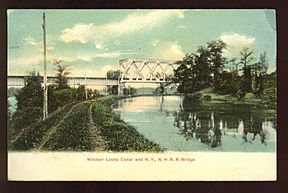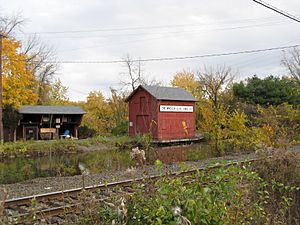Enfield Falls Canal facts for kids
Quick facts for kids Enfield Falls Canal |
|
|---|---|

Windsor Locks Canal and railroad bridge (postcard mailed in 1909)
|
|
| Specifications | |
| Length | 5.25 miles (8.45 km) |
| Locks | 1 (north end); 3 (south end) |
| Status | Closed |
| Navigation authority | |
|
Enfield Falls Canal (Windsor Locks Canal)
|
|
| Lua error in Module:Location_map at line 420: attempt to index field 'wikibase' (a nil value). | |
| Nearest city | Windsor Locks, Connecticut |
| Area | 55 acres (22 ha) |
| Built | 1829 |
| Engineer | Canvass White |
| NRHP reference No. | 76001998 |
| Added to NRHP | April 22, 1976 |
| History | |
| Construction began | 1827 |
| Date completed | November 11, 1829 |
| Geography | |
| Start point | 41°59′12″N 72°36′19″W / 41.9866°N 72.6053°W |
| End point | 41°55′01″N 72°37′29″W / 41.9169°N 72.6248°W |
The Enfield Falls Canal, also known as the Windsor Locks Canal, is a historic canal in Connecticut, USA. It was built to help boats get around the shallow and rocky parts of the Connecticut River called Enfield Falls or Enfield Rapids. This canal is located on the west side of the river, next to the towns of Suffield and Windsor Locks. The town of Windsor Locks even got its name from the special water gates, called locks, on the canal.
Why the Canal Was Needed
Before the canal was built, boats on the Connecticut River faced a big problem. Flat-bottomed boats, called scows, struggled to pass the Enfield Falls. The water there was too shallow and fast.
To get past the falls, boat crews had to hire local workers called "fallsmen." These fallsmen would use long poles to push the boats forward. Imagine pushing a heavy boat against a strong current!
This method was very slow and expensive. Also, boats could only carry about ten tons of cargo. If a boat had more goods, the extra cargo had to be unloaded. It was then stored or carried around the falls by teams of oxen. This made moving goods much harder and cost more money.
Building the Canal
Work on the Enfield Falls Canal began in 1827. It took two years to build, and it officially opened on November 11, 1829. The canal stretched for about 5.25 miles (8.45 kilometers).
The canal was designed to handle a total drop in water level of 32 feet (9.8 meters). It had special locks that could fit boats up to 90 feet (27 meters) long and 20 feet (6.1 meters) wide.
This canal was special because it was built strong enough for steamboats. It also had a huge gate at the start. This gate could open and close to carefully control the water level inside the canal and its locks.

The people who built the canal had two main goals. First, they wanted to earn money from tolls, which were fees charged to boats using the canal. Second, they planned to sell land for factories and rent out water rights to mill owners along the canal. This way, factories could use the canal's water power.
Life After the Canal Opened
Once the canal was open, boats could carry much larger loads. New steamboats were designed to fit through the locks, making river travel faster and easier. Famous writer Charles Dickens even traveled along the canal on February 7, 1842.
However, the canal's success as a shipping route didn't last forever. By 1844, the Hartford and Springfield Railroad began operating. Trains could move goods even faster than boats. Because of this, river shipping slowly became less popular.
Even though boat traffic decreased, the canal still made money. Selling water rights to factories and mills turned out to be more profitable than the tolls from boats. The canal became an important source of power for local industries.
The Canal Today
Today, the Enfield Falls Canal is no longer used for boats. It is listed on the National Register of Historic Places, which means it's an important historical site. The Ahlstrom Corporation, a manufacturing company, owns the canal and has a factory next to it.
The original locks still exist, but they haven't been used since the 1970s. Most of the old towpath, which was used by animals to pull boats, is now a public trail. It's called the Windsor Locks Canal State Park Trail. People can go hiking and cycling there.
The trail is usually open from April 1 to November 15. However, the southern part of the trail might be closed sometimes. This is because a pair of bald eagles has been nesting there since 2011, and their nesting area needs to be protected.

